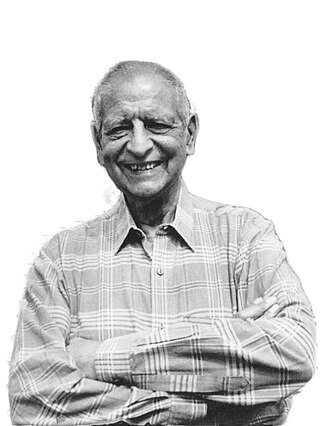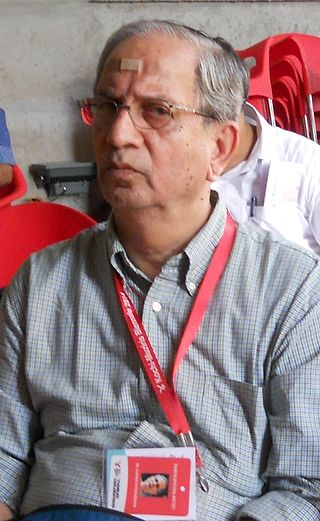
Ratan Parimoo is an Indian art historian from Kashmir, who has worked as an art educator, pedagogue, artist and former director of the Lalbhai Dalpatbhai Museum, Ahmedabad. Ratan Parimoo was one of the founder members of Baroda Group.

Ghulam Mohammed Sheikh is a painter, poet and art critic from Gujarat, India. He was awarded the Padma Shri in 1983 and Padmabhushan in 2014 for his contribution in field of art.

Lalita Lajmi was an Indian painter. She was a self-taught artist born into a family involved in the arts, and was very fond of classical dance even as a child. She was the sister of Hindi film director, producer, and actor Guru Dutt. In 1994, she was invited to the Guru Dutt Film Festival, organised by Gopalkrishna Gandhi, the Indian High Commissioner at Nehru Centre, London. Her work was also influenced by Indian films such as those made by her brother, Satyajit Ray and Raj Kapoor.

Arpita Singh is an Indian artist. Known to be a figurative artist and a modernist, her canvases have both a story line and a carnival of images arranged in a curiously subversive manner. Her artistic approach can be described as an expedition without destination. Her work reflects her background. She brings her inner vision of emotions to the art inspired by her own background and what she sees around the society that mainly affects women. Her works also include traditional Indian art forms and aesthetics, like miniaturist painting and different forms of folk art, employing them in her work regularly.
Reena Saini Kallat is an Indian visual artist. She currently lives and works in Mumbai.
Jyotindra Manshankar Bhatt, better known as Jyoti Bhatt, is an Indian artist best known for his modernist work in painting and printmaking and also his photographic documentation of rural Indian culture. He studied painting under N. S. Bendre and K.G. Subramanyan at the Faculty of Fine Arts, Maharaja Sayajirao University (M.S.U.), Baroda. Later he studied fresco and mural painting at Banasthali Vidyapith in Rajasthan, and in the early 1960s went on to study at the Academia di Belle Arti in Naples, Italy, as well the Pratt Institute in New York. He was awarded the Padma Shri in 2019 and elected as a Fellow of the Lalit Kala Akademi in 2022.

Asia Art Archive (AAA) is a nonprofit organisation based in Hong Kong that documents the recent history of contemporary art in Asia within an international context. AAA incorporates material that members of local art communities find relevant to the field, and provides educational and public programming. AAA is one of the most comprehensive publicly accessible collections of research materials in the field. In activating its collections, AAA initiates public, educational, and residency programmes. AAA also offers research grants and publishes art and cultural criticism on its online platform 'Like a Fever'.

Geeta Kapur is a noted Indian art critic, art historian and curator based in New Delhi. She was one of the pioneers of critical art writing in India, and who, as Indian Express noted, has "dominated the field of Indian contemporary art theory for three decades now". Her writings include artists' monographs, exhibition catalogues, books, and sets of widely anthologized essays on art, film, and cultural theory.
Gayatri Sinha is an art critic and curator based in New Delhi, India. Her primary areas of research are around the structures of gender and iconography, media, economics and social history. She founded Critical Collective, a forum for thinking about conceptual frames within art history and practice in contemporary India.

Kekoo Gandhy was an Indian art gallerist, art collector and art connoisseur, who pioneered the promotion of Indian modern art from the 1940s. He established Chemould Frames, a frame manufacturing business in 1941, soon he started displaying works of young modern artists K. H. Ara, S. H. Raza, K. K. Hebbar and M. F. Husain in his showroom windows. This led to gradual rise of modern art movement and post-colonial art in India. Eventually Gallery Chemould, India's first commercial art gallery, was opened in 1963 on the first floor of the Jehangir Art Gallery.
Anita Dube is an Indian contemporary visual artist and art critic, whose work has been widely exhibited. She is known for her mixed media sculpture and installation art.
Chemould Prescott Road, founded, is the first contemporary art gallery in Mumbai, India.

Sudhir Patwardhan is an Indian contemporary painter and a practising radiologist.
Sheela Gowda is a contemporary artist living and working in Bangalore. Gowda studied painting at Ken School of Art, Bangalore, India (1979) pursued a postgraduate diploma at Visva-Bharati University, Santiniketan, India (1982), and a MA in painting from the Royal College of Art in London in 1986. Trained as a painter Gowda expanded her practice into sculpture and installation employing a diversity of material like human hair, cow-dung, incense and kumkuma powder. She is known for her 'process-orientated' work, often inspired by the everyday labor experiences of marginalized people in India. Her work is associated with postminimalism drawing from ritualistic associations. Her early oils with pensive girls in nature were influenced by her mentor K. G. Subramanyan, and later ones by Nalini Malani towards a somewhat expressionistic direction depicting a middle class chaos and tensions underplayed by coarse eroticism. She is the recipient of the 2019 Maria Lassnig Prize.

Nalini Malani is an Indian artist, among the country's first generation of video artists.

Madhvi Parekh is an Indian contemporary artist living in New Delhi.
Mithu Sen is an Indian conceptual artist. Born in West Bengal in 1971.
The GROUP 1890 exhibition was held from 20 to 29 October 1963 at Lalit Kala Akademi, Rabindra Bhavan in New Delhi, India. It was the only exhibition of the artist collective 'group 1890', hence the only existing record of the group's exhibition history in the 1960s contemporary art in India. The group was an entirely male association with 12 members which 'stood passionately and romantically for values of modernism that signaled change'. The members were Raghav Kaneria, M. Reddeppa Naidu, Ambadas Khobragade, Rajesh Mehra, Gulam Mohammed Sheikh, Jagdish Swaminathan, Himmat Shah, Jeram Patel, S. G. Nikam, Eric Bowen, Jyoti Bhatt, and Balkrishna Patel. All of which participated in this inaugural exhibition.
The Baroda Group refers to the artists involved with the Faculty of Fine Arts at Maharaja Sayajirao University of Baroda, now known as Vadodara in Gujarat state of India. An experimental art school that drew artists of a variety of backgrounds, the Baroda Group offered an alternative to the nationalism associated with Santiniketan and the Bengal School.

The Jehangir Nicholson Art Foundation (JNAF) is a private, not-for-profit organization located in Mumbai, India, with its core interest in promoting the preservation, exhibition, education, and research of post-colonial Indian modern art. The collection is endowed by the personal collection of the late Jehangir Nicholson, comprising over 800 pieces of art across mediums from artists including M. F. Husain, Vasudeo S. Gaitonde, S. H. Raza, K. H. Ara. The foundation is currently housed in the Chhatrapati Shivaji Maharaj Vastu Sangrahalaya (CSMVS), and functions as the modern and contemporary art wing of the museum.











